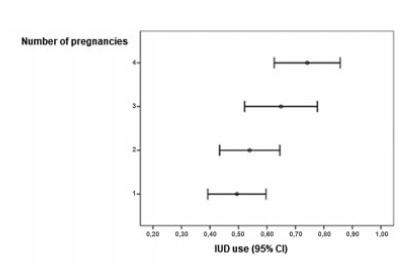-
Original Article
Immediate Postpartum Copper IUD: A Comparative Analysis between Profiles of Women who Accept and who Refuse it
Revista Brasileira de Ginecologia e Obstetrícia. 2022;44(2):154-160
04-08-2022
Summary
Original ArticleImmediate Postpartum Copper IUD: A Comparative Analysis between Profiles of Women who Accept and who Refuse it
Revista Brasileira de Ginecologia e Obstetrícia. 2022;44(2):154-160
04-08-2022Views125Abstract
Objective
To analyze the profiles of women who accepted and who refused the insertion of the copper intrauterine device (IUD) postpartum and to learn the motivations related to the refusal of the method.
Methods
Cross-sectional study with 299 pregnant women. The women were informed about the possibility of inserting a copper IUD postpartum and were questioned about their interest in adopting or not this contraceptive. All participants answered a questionnaire with information relevant to the proposals of the present study. The sample size was limited to the number of devices available for the present study.
Results
A total of 560 women were invited to join the present study and 299 accepted. Out of the 299 women included in the present study, 175 accepted the copper IUD and 124 refused. As the number of pregnancies increased, the IUD acceptance rate raised (p=0.002), especially between the groups with 1 and with ≥ 4 pregnancies (p=0.013). Regarding the desire to havemore children, the women who planned to have more children were more likely to refuse the method than the ones who did not (p<0,001).
Conclusion
Women with multiple pregnancies and desire to not have more children were more likely to accept the copper IUD. The profile of those who refused was first pregnancy and desire to have more children. Among the three most frequent reasons reported for copper IUD rejection, two responses stood out: no specific justification and desire to have more children.
Key-words Contraceptioncopper intrauterine deviceFamily planning servicesIntrauterine devicesPostpartum periodSee more
-
Artigos Originais
Contraceptive methods in the public health service (“Sistema Único de Saúde”) in Maringá-PR
Revista Brasileira de Ginecologia e Obstetrícia. 2006;28(5):271-277
08-28-2006
Summary
Artigos OriginaisContraceptive methods in the public health service (“Sistema Único de Saúde”) in Maringá-PR
Revista Brasileira de Ginecologia e Obstetrícia. 2006;28(5):271-277
08-28-2006DOI 10.1590/S0100-72032006000500002
Views83See morePURPOSE: to evaluate the contraceptive methods adopted by the public health system of Maringá County, Paraná, regarding the orientations for using them, indications, contraindications and reasons for interrupting these methods, as well as the profile of the female users. METHODS: transversal descriptive study, performed through 284 home interviews with women selected from the 62 groups of the Family Health Program, after their free and informed consent, and after the questionnaire had been approved by the Ethics in Research Committee involving human beings of the State University of Maringá (Universidade Estadual de Maringá - UEM). Before applying the questionnaires, they were pretested, focusing on the following sections: characterization of the interviewee, socioeconomical factors and contraceptive methods. Results were analyzed using the Statistical Package for the Social Sciences software 12.0 version. RESULTS: most women were white, married, between 35 and 49 years old, with high school education, working without salary, and from D and E economical classes. Of them, 22.5% were smokers and 4.9% alcohol users. Contraceptive pills were adopted by 50.3% of the women; condom by 28.1% and tubal ligature by 32%, following, in general, the health professional orientation. Reasons for interrupting the contraceptive methods were the wish to get pregnant, preference for a permanent method, and also because of the side effects of the pill. Smoking was the most prevalent risk factor for pill use. Only 35.9% of the interviewed women started using the pill after a previous medical visit, and almost in the same proportion, 33.6%, without visit before starting to use it. CONCLUSIONS: it was observed that the indications of the contraceptive method to be used, and the orientations accomplished by the health professionals were satisfactory, despite the high levels of tubal ligature and the detection of relative contraindications for pill users with more than 5 years of use.


